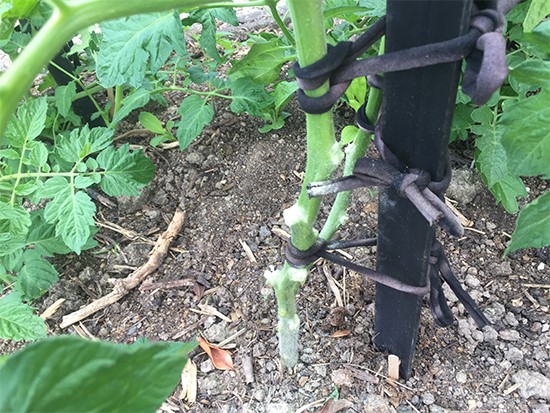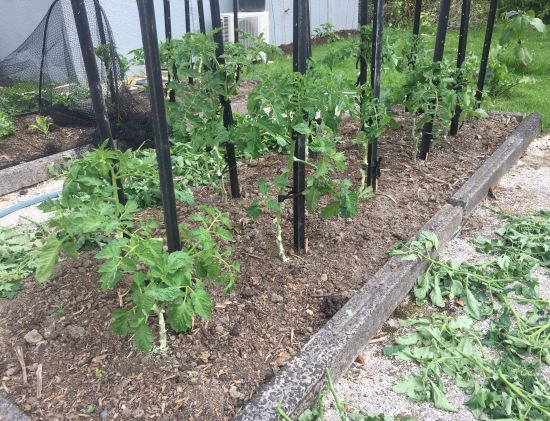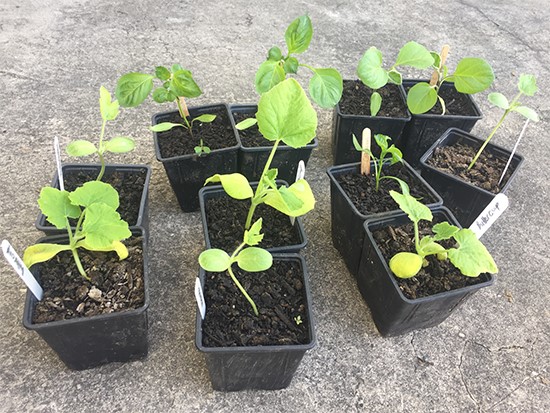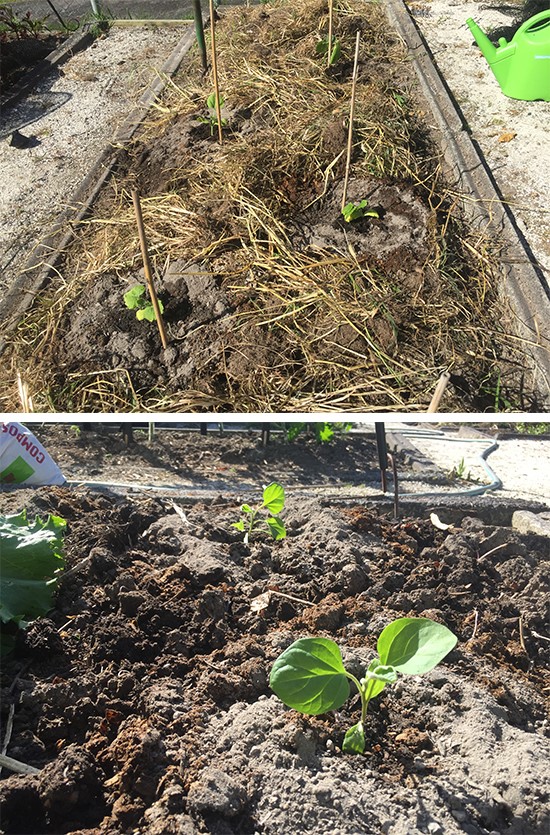Just a quick note at this time to discuss delateralling tomatoes mainly.
This is how beautiful our tomatoes look.

BUT, all that foliage restricts air circulation which helps prevent fungal infection and with less foliage, the plant can focus its energy on fruit production.
So how do you do it? Firstly, make sure it’s not a humid day – the sky should be blue and there should be a reasonable wind blowing. And you’ll need these things – cloth ties, a paint brush, Flowers of Sulphur, secateurs.

Firstly we identify two strong leaders – there will be an obvious one and then choose another which is growing in the right direction and looks like it could develop well.
Starting at the bottom of the plant, clear most of it away. Any laterals that are growing downwards need to be removed.
The way to remove a lateral is by snapping it up and down with your hands and it will make a clean break in most instances. If it doesn’t you can use secateurs. Make sure you remove the little laterals that grow in the crooks.

Afterwards gently tie up the two leaders with cloth ties, threading it around the leader first, then onto the stake.
Then using a paint brush we dab Flowers of Sulphur on the wounds to help them heal well. Fungal infection can enter a wound, so we need to be careful.


We plant basil and marigolds around our tomatoes as companion plants. Basil and tomatoes taste better for being planted together and the smell of marigolds helps keep unwanted pests at bay as well as attracting bees and beneficial insects.
I’m direct planting the marigolds out of their seed-sowing tray because they’re big enough. I’m just watering the marigolds and won’t water the tomatoes for a couple of days until those wounds are sealed as the combination of watering and humidity can cause blight. On that note, always water tomatoes in the morning so the plants have time to dry out during the day – this helps prevent blight.

I’ve pricked out the basil plants and remaining marigolds and will grow those on a bit.

Our cucurbits (pumpkin, cucumber, watermelon and zucchini) and solanums (capsicums and eggplants) are still small, but I have just planted them out. When I upended them to plant them, the root structure was good, so they should pull away well. I’ll keep a close eye on them. Last year I left them until they were bigger and really missed the best time get them in the ground.

Remember to plant them in plenty of compost, and round the edge of the plant apply either chicken manure or sheep pellets and a good fertiliser like our Natures Organic Fertiliser which contains calcium to help prevent blossom end rot. You can also add gypsum (calcium) to the planting hole of capsicums and eggplants. And with the rambling plants (pumpkin, cucumber, watermelon) place a stake near the rootball for watering purposes.

Next jobs are getting some more potatoes in and sowing more carrots while we’re in this Full Moon phase. Enjoy the warm weather!
From Jan and Rob.
Website designed by www.thecornerstorecollective.com
Developed by Richard Hpa
11 Responses
Could you explain more about ‘placing a stake beside the pumpkin root ball for watering purposes’?
Oh just that when you’re watering the plant you know where the root ball is if there’s a stake there. Otherwise the plant rambles away and you could be watering leaves but not the roots.
Thank you very much for this wonderful information! Where can I buy Flowers of Sulphur and Nature’s organic fertiliser? I couldn’t find them at Mitre 10 Rangiora and they had no idea what I was talking about. Diane
Hi Diane The Flowers of Sulphur I’ve got used to be readily available at garden centres, but a quick google makes me realise it isn’t. Anyway here’s the link to the people who make it… http://riversideproducts.co.nz/products_id_anytime4f72564f3c02c.html and I’m sure if you contact them, they’ll help out.
Natures Organic Fertiliser is made by the good people at Environmental Fertilisers in Paeroa and we stock it… https://organicediblegarden.co.nz/product/natures-organic-fertiliser/
I Have been told thatthe leaves and flowers from a Rodedendron tree are not good for composting also Camelias.
Is this correct. Thank you Eddie.
Hi there Rhodendron leaves and camellia leaves to a lesser extent will take ages to break down in a compost, so probably best left out. All the best 🙂
Many thanks for your information, always learn something new from you. Like Diane mentioned above, I also inquired at a Garden Centre for Flowers of Sulphur, they sold me Wally’s Sulphur powder and said it is the same product, do you know if this is correct ?
Yes it is. I’ve just had a look on Wally’s site and it is Flowers of Sulphur 🙂
Are the flowers of the Rodo ok to compost
Are the flowers of the Rodo ok to compost.
Not answerd in last post.
Sorry for the oversight. We wouldn’t compost rhododendron flowers or leaves. Not only are the leaves hard to break down, but there is evidence that both the leaves and flowers have a level of toxicity in them.